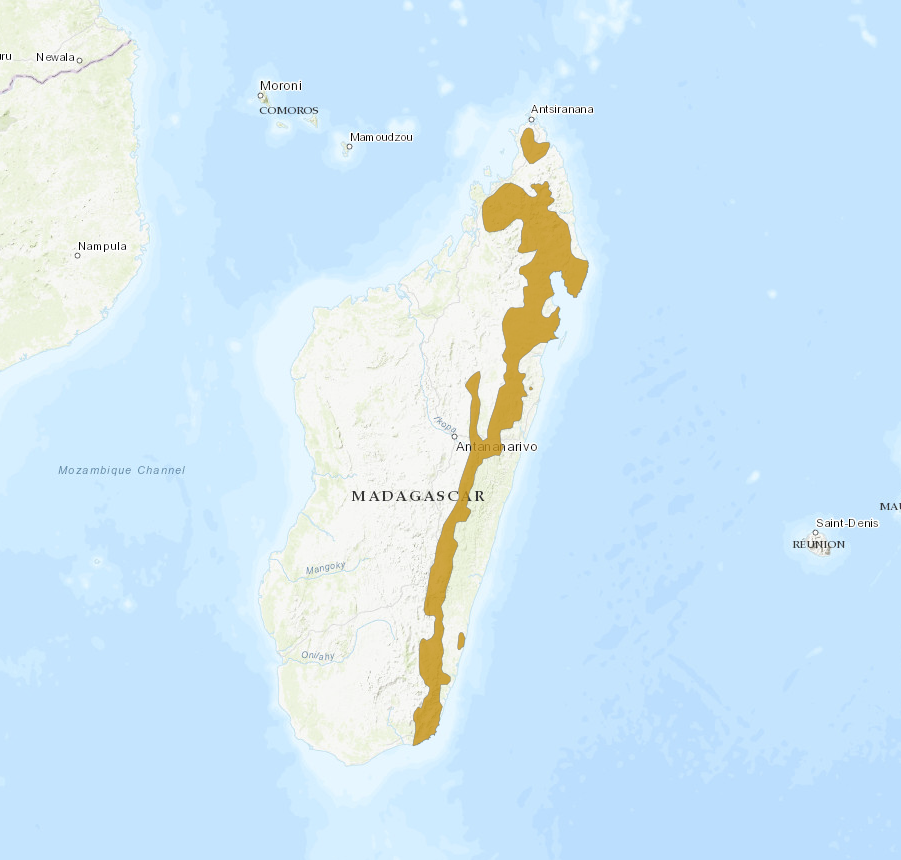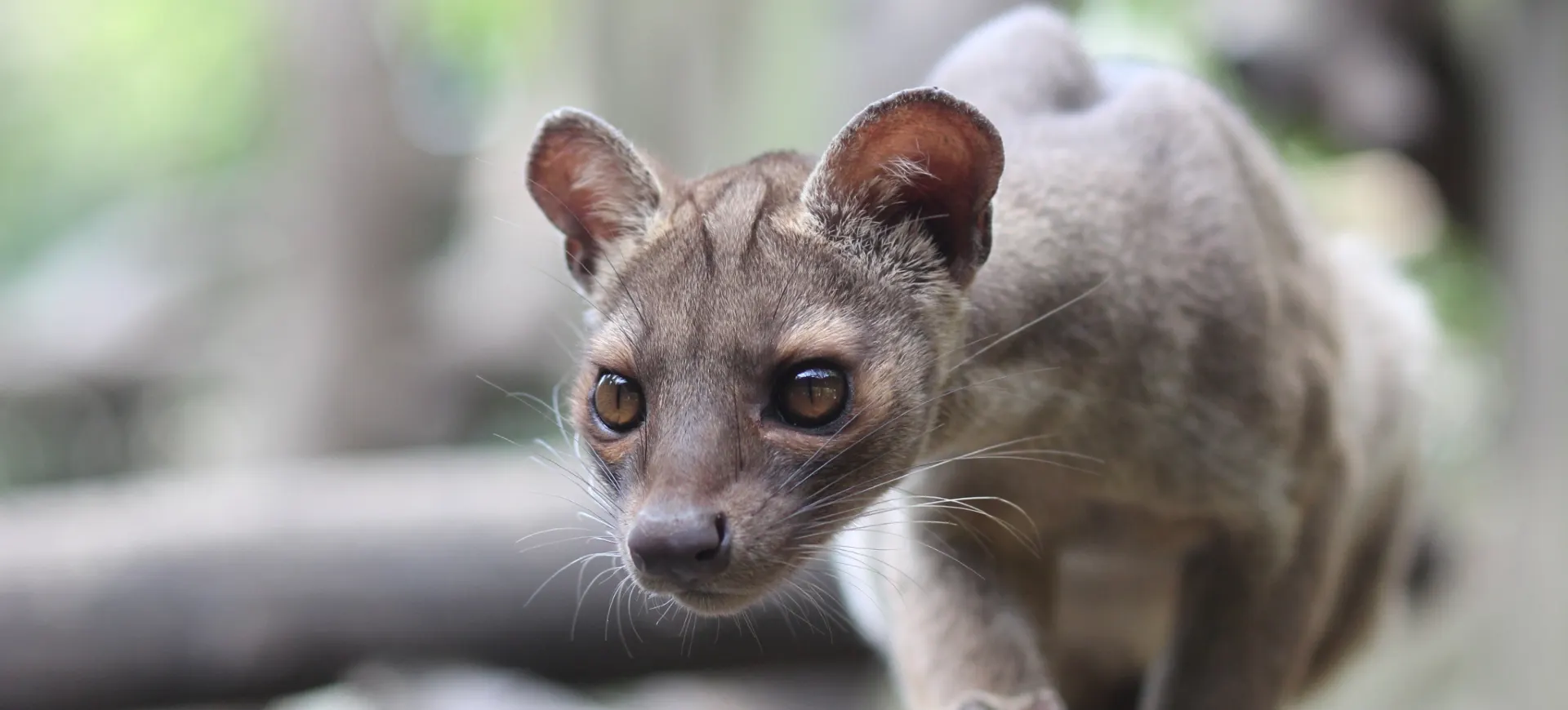Overview
The Malagasy civet, known scientifically as Fossa fossana, is a small carnivorous mammal native to Madagascar. Unlike its larger relative, the fossa (Cryptoprocta ferox), the Malagasy civet is more closely aligned in size and habits to traditional civets in other parts of the world. It primarily inhabits the tropical rainforests of Madagascar, although it can also be found in other forest types and occasionally in more disturbed habitats. This nocturnal creature is elusive, and much of its life remains a mystery, contributing to the challenges of conservation efforts.
The Malagasy civet’s diet is varied, including small vertebrates and invertebrates, with a preference for insects and small mammals. Its role in the ecosystem is crucial, as it helps control the populations of its prey, thereby maintaining the ecological balance. The species exhibits solitary behavior, coming together with others only for breeding purposes. Its distinctive features include a greyish-brown coat with spots and stripes, a long snout, and a bushy tail, which aid in camouflage and communication.
The conservation status of the Malagasy civet is concerning due to habitat destruction, fragmentation, and the decline in prey populations. These threats are exacerbated by the species’ limited range, confined to an island with rapidly changing environmental conditions. Efforts to conserve the Malagasy civet include habitat protection and restoration and research to better understand its ecology and behavior.
Taxonomy
Kingdom
Phylum
Class
Order
Family
Genus
Species
Type
Current distribution:
The Malagasy civet is found exclusively in Madagascar, primarily in the eastern and northeastern parts of the island. However, its presence is increasingly fragmented due to habitat destruction and degradation. The civet's adaptability has allowed it to survive in secondary forests and degraded areas, although these are not ideal for long-term survival.
Conservation efforts are focused on preserving the remaining forested areas where the Malagasy civet is found. Despite these efforts, accurate data on its population and distribution are scarce, complicating conservation strategies. Continued research and monitoring are essential to understanding the civet's current range and implementing effective conservation measures.
Physical Description:
The Malagasy civet boasts a slender body measuring around 47 to 65 centimeters, with a tail that adds 20 to 30 centimeters. Its fur is primarily greyish-brown, adorned with a series of dark spots and stripes that provide camouflage within its forested habitat. The animal has small, rounded ears, a long snout, and sharp claws that aid in climbing and capturing prey. Its eyes are equipped for nocturnal activity, featuring a reflective layer that enhances night vision.
Males and females exhibit slight size dimorphism, with males generally being larger. This civet’s physical adaptations, including a flexible spine and semi-retractable claws, highlight its evolutionary optimization for an arboreal and terrestrial lifestyle. The species’ agility and stealth are crucial for hunting and evading predators in the dense forests of Madagascar. The Malagasy civet’s appearance serves practical purposes and contributes to its unique place within Madagascar’s rich biodiversity.

Lifespan: Wild: ~10 Years || Captivity: ~21 Years

Weight: Male: 3.3-4.4 lbs (1.5-2 kg) || Female: 2.9-3.9 lbs (1.3-1.8 kg)

Length: Male: 18.5-25.6 in (47-65 cm) || Female: 17.7-24.8 in (45-63 cm)

Top Speed: 12 mph (19 km/h)
Characteristic:
Native Habitat:
The Malagasy civet is endemic to Madagascar, with a preference for the island’s eastern rainforests. Its habitat ranges from lowland forests to montane regions, demonstrating the species’ adaptability to various forest types. The civet’s presence in these areas is often indicated by tracks or the distinctive musky scent it leaves behind. Its ability to thrive in dense vegetation is crucial for its hunting and nesting practices.
Despite its adaptability, deforestation, agriculture, and human settlement expansion threaten the Malagasy civet’s habitat. Conservation of its habitat is critical for the civet and the myriad of other species that share its environment. Efforts to protect and restore its natural habitat are vital for ensuring the Malagasy civet’s future.
Biomes:
WWF Biomes:
Biogeographical Realms:
Continents:
Countries:
Diet:
Diet & Feeding Habits:
The Malagasy civet is primarily insectivorous but is known to exhibit omnivorous tendencies. Its diet can also include small mammals, birds, frogs, and occasionally fruit. Its foraging behavior is solitary, relying on the cover of night to hunt. The civet uses its keen sense of smell to locate prey and its sharp teeth and claws to catch and consume it. This dietary flexibility plays a crucial role in its survival, allowing it to adapt to seasonal changes in food availability.
In the wild, the Malagasy civet’s feeding habits contribute to seed dispersal and the control of insect populations, highlighting its integral role in the ecosystem. The civet’s predation patterns indicate its opportunistic feeding strategy, essential for navigating the competitive and ever-changing Madagascar environment. Human encroachment and habitat loss have impacted the civet’s food sources, necessitating closer study to ensure its continued survival.
Mating Behavior:
Mating Description:
The Malagasy civet’s mating habits are not well-documented, but it is believed to breed once a year. The species is considered polygynous, with males competing for access to females. Mating typically occurs during the rainy season, when food resources are more abundant. Gestation lasts approximately two to three months, culminating in the birth of one to two offspring.
Offspring are born in secluded dens hidden in dense forest undergrowth. These dens protect the young from predators and the elements. The mother cares for the young and is solely responsible for their upbringing. The offspring remain dependent on their mother for several months before venturing out on their own, a crucial period for learning survival skills.
Reproduction Season:
Birth Type:
Pregnancy Duration:
Female Name:
Male Name:
Baby Name:
Social Structure Description:
The Malagasy civet is a solitary animal, with individuals only coming together for mating. Outside the breeding season, civets maintain their territories, which they mark with scent markings to communicate with other civets and delineate their area. This solitary nature is considered an adaptation to a lifestyle that relies on stealth and secrecy for hunting and survival.
Within its territory, the Malagasy civet has specific areas for feeding, resting, and breeding. The dense forest environment provides ample opportunities for hiding and hunting, allowing the civet to utilize its keen senses and agility. The social structure of the Malagasy civet, while not highly complex, is crucial for its survival in the wild, balancing competition and the need for reproduction.
Groups:
Conservation Status:
Population Trend:
The population of the Malagasy civet is difficult to ascertain due to its nocturnal habits and elusive nature. However, it is known that the population is declining, primarily due to habitat destruction and fragmentation. The civet’s dependence on forest habitats makes it particularly vulnerable to deforestation for agriculture, logging, and human settlement. In addition to habitat loss, the Malagasy civet faces threats from hunting and competition with invasive species.
Conservationists are concerned about the long-term viability of the Malagasy civet population without significant intervention. Efforts to monitor the population are hampered by the civet’s secretive lifestyle and the challenging terrain of its habitat. Continued research and surveying are crucial for understanding population dynamics and developing effective conservation strategies.
Population Threats:
Habitat destruction is the primary threat to the Malagasy civet, with large swathes of Madagascar’s forests being cleared for agriculture and timber and to make way for human settlement. This loss of habitat reduces the civet’s available living space and impacts its prey base, further threatening its survival. Additionally, the civet is hunted for its meat and perceived as a pest in some areas, leading to direct persecution.
Climate change also poses a significant threat to the Malagasy civet, potentially altering its habitat and the availability of food resources. The combined effects of these threats place increasing pressure on the remaining populations, highlighting the urgent need for comprehensive conservation measures.
Conservation Efforts:
Conservation efforts for the Malagasy civet include protecting habitat and establishing protected areas within its range. Curbing deforestation and engaging local communities in conservation practices are also crucial. Environmental education programs aim to raise awareness about the civet and its role in the ecosystem, promoting coexistence and reducing hunting pressures.
International collaboration and research are vital for developing effective conservation strategies. Studies on the civet’s ecology, behavior, and population dynamics provide the data for informed decision-making. Conservationists are also exploring the potential for ecotourism to provide alternative livelihoods for local communities, thereby reducing the incentive for habitat destruction.
Additional Resources:
Fun Facts
- The Malagasy civet is also known as the fanaloka or the Eastern falanouc.
- Despite its common name, the Malagasy civet is not a true civet but belongs to the family Eupleridae, which includes all Malagasy carnivores.
- Its musky scent for communication and marking territory is stronger and more distinct than many other small carnivores.
- The Malagasy civet’s diet and foraging behavior make it a crucial component of its ecosystem, helping to control insect and small vertebrate populations.
- Its elongated body and short legs adapt to an omnivorous diet and a semi-arboreal lifestyle.
- The civet’s fur pattern provides camouflage in the dappled light of its forest habitat, aiding in stealth.
- They are primarily nocturnal, which helps reduce competition with diurnal predators and allows them to avoid the hottest parts of the day.
- The Malagasy civet is one of Madagascar’s unique species, contributing to the island’s high level of biodiversity.
- Conservation efforts for the Malagasy civet also benefit other endemic species sharing its habitat.
- The secretive nature of the Malagasy civet makes it a challenge for researchers to study, contributing to its mystique and allure in the scientific community.








